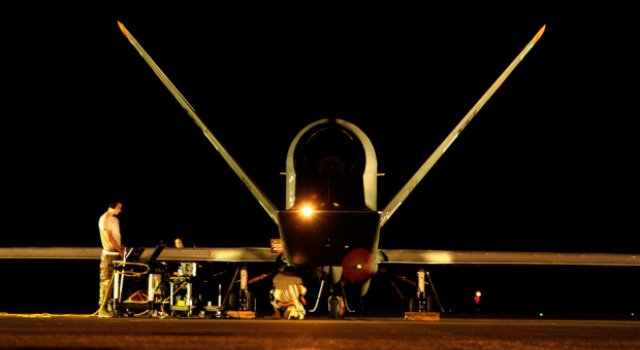Global Hawks, America’s largest unmanned surveillance aircraft, will fly out of Japan for the first time this summer, the Air Force says.Interest in the UAS — ranging from NASA to NATO and other U.S. allies — has been rising due to their versatility and endurance. Two of them, along with 40 personnel, will deploy to Misawa Air Base from May to October, according to 1st Lt. Caitlin Suttie, a public affairs officer with the 35th Fighter Wing at Misawa.
“The plan to deploy more advanced capabilities in Japan, such as the Global Hawk, has strategic significance and further contributes to the security of Japan and the region,” she said in an email Friday.
The aircraft and personnel will travel from Andersen Air Force Base, Guam, where Global Hawks — controlled by remote operators in California — have been based for three years.
The Guam-based aircraft played a key role in the disaster relief effort that followed the earthquake, tsunami and nuclear disaster that struck Japan in March 2011. More recently they flew missions over the Philippines as part of the Typhoon Haiyan relief effort in November.
Global Hawks are also a key tool in keeping tabs on North Korea’s nuclear weapons development and Chinese naval manoeuvres. Both are of particular interest to the Japanese government, which recently approved plans to acquire three of its own large unmanned surveillance aircraft.
Global Hawk manufacturer Northrop Grumman appears confident that the Japanese will buy its aircraft.
“We have good reason to be optimistic,” Curtis Orchard, Northrop Grumman regional director and vice president, said in Japan this month.
George Guerra, Northrop Grumman’s vice president of strategic high-altitude, long-endurance ventures, said there’s also interest from South Korea and Australia, which is negotiating to buy the Triton — a maritime version of the aircraft.
Northrop Grumman is already building five more Global Hawk’s for a consortium of 13 NATO nations. The NATO aircraft, along with some of the U.S. Navy’s Tritons, will fly out of Sigonella, Sicily, which is already home to Air Force Global Hawks, Guerra said.
The Global Hawks at Misawa would support missions throughout the Pacific, he said.
“They can cover a vast area,” he said, noting that missions out of Guam last 30 to 31 hours.
The aircraft, which has logged more than 100,000 flight hours — about 90,000 in support of combat or humanitarian efforts — had the best safety record of any platform in the U.S. Air Force last year, he said.
“The Global Hawks on Guam are achieving more than 80 percent reliability… (and) we are seeing comparable performance at the other locations,” Guerra said.
A NASA Global Hawk will start six to eight weeks of operations out of Guam by the end of the month, gathering atmospheric and storm data for researchers, he said.
Later this year, the Air Force will send two or three “Block 40” models of the Global Hawk to Guam to join the “Block 30” aircraft that are there already. The Block 30s carry radar, infra-red sensors and signals intelligence systems whereas the Block 40s include advanced radar for interdicting ground targets, he said.
Source: Stars and Stripes

